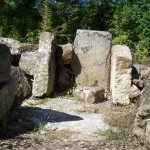Population in Hillfeet
Dolmens of the Novorossiysk Area
Dolmens are funerary megalithic structures of stone box, the floor, walls and roof of which are made of massive slabs or blocks of sandstone or other rock materials with the entrance-hole in the front wall. Usually such a box is a chamber in which the remains of the buried people and accompanying items had been placed: dishes, tools, current food and the complex was put into a mound of rubble, slabs and blocks.
Due to the poor preservation of the vast majority of dolmens, which is due to robbery or destruction of such graves in the antiquity and in the new and newest times, history, culture and living conditions of the builders of dolmens have been insufficiently studied. The problem of their dating is not completely solved.
According to the reports the ancient dolmens in the Caucasus appeared in the early Bronze Age, or in the IV millennium BC. The great mass had been built during the third and beginning of the second millennium. Many of the excavated dolmens graves contained the remains of the middle and later periods of the Bronze Age and even the century of iron. But it is likely that these burials had been placed in the more ancient structures.
Dolmen groups or cemeteries on the Abrau peninsula (all data are available for 7 of the monuments, but only a part of them) which remained are the most western territory to spreading the dolmen culture. Two groups on the right bank of the Ozereyka river are excavated and partially restored by a Novorossiysk archaeologist A. Dmitriev. One contains the remains of three large dolmens had been put in to round stone mounds lined along the perimeter by cyclopean masonry and fused together. The other includes several smaller dolmenboxes.
The tribes of the Bronze Age people who built the dolmens and buried their dead in them, lived on the Black Sea coast and in the mountain valleys of the northern slopes of the Caucasus Mountains. Close neighbors of the steppe tribes were pastoralists, belonging to the so-called Catacomb-culture. Certain contacts between the mountain and steppe population had been traced. This is evidenced by the similarity of the material culture by handmade dishes, shape of the tools and weapons, metal products and decorations. However, a fundamental difference in funeral rites and funeral structures indicates that both groups were aware of their differences and features and clearly distinguished between “ours” and “strangers”.




